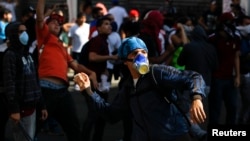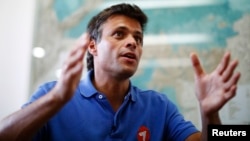CARACAS —
This week's explosion of violence in Venezuela has again put a spotlight on militant grassroots groups called “colectivos”, which view themselves as the defenders of revolutionary socialism but are denounced by opponents as thugs.
A well-known colectivo leader was shot dead during competing political demonstrations in Caracas on Wednesday, while opposition activists blamed colectivos for starting the violence in which two other people died.
Colectivo members have taken to state TV to call for calm and demand the arrest of opposition leader Leopoldo Lopez, whom they accuse of inciting bloodshed.
Using a slogan “The Exit”, the U.S.-educated Lopez has for two weeks helped organize sporadic demonstrations around the country to denounce President Nicolas Maduro for failing to control inflation, crime and product shortages.
The colectivos emerged during the rule of the late Hugo Chavez as the self-appointed guardians of his leftist policies.
From running security in their communities to drumming up support for government anti-poverty efforts, they function as an informal extension of the Socialist Party, frequently blurring the lines between partisan activism and community service.
They are a key part of government's electoral “machinery”, and they can move voters at the last minute to help sway close races and are sometimes tarred by critics as poll station thugs who intimidate opponents.
The colectivos point to their bookshops, study groups, summer camps for children, and coffee mornings for pensioners as genuine services to their communities. They frequent government marches and rallies to keep opposition meddlers away.
Maduro, Chavez's successor, said he had known the dead colectivo leader, Juan “Juancho” Montoya, since Montoya was 14 in the poor, staunchly pro-government 23 de enero (January 23) neighborhood of Caracas.
“He was a fighter and a comrade,” said Glen Martinez, leader of colectivo Radio23. “Juancho was a brother and a friend. Peace cannot be placed above justice, and without justice there can't be peace.”
The groups are scattered around the nation and probably have only a few thousand members. The dozen or so best-known are all based in the colectivos' heartland: the 23 de enero barrio near the center of Caracas.
The 23 de enero area is home to about 100,000 people. Security is almost entirely in the hands of the colectivos. Some set up armed roadblocks at night, communicating by walkie-talkie, stopping cars and questioning passengers.
Despite the groups' unstinting support for the government, their overt thuggishness can pose a public relations nightmare for the authorities.
The colectivos are accused of assaulting staff at opposition TV stations, sending death threats to print journalists, and even tear-gassing the residence of the Vatican envoy in 2009 after Chavez accused the Catholic Church of meddling in politics.
“The colectivos are paramilitary groups armed by the government and protected by officials in uniform,” Lopez, the opposition leader, told Reuters after Wednesday's violence.
Montoya told Al Jazeera in a interview last year that if the opposition had defeated Maduro in the April 2013 election to replace Chavez, his group wouldn't have accepted the outcome.
“Real Revolutionaries?”
There was a scandal in 2012 after one colectivo, “La Piedrita”, posed children apparently clutching assault rifles and copies of Venezuela's constitution for a photo in front of a mural that depicted Jesus and the Virgin Mary armed with AK-47s.
The group later said the guns were replicas, but there was an angry public backlash after the pictures were circulated widely on social media. Chavez himself said the photo was “indefensible”.
He questioned if La Piedrita, which alludes to the saying “a pebble in the shoe”, a nuisance, were “real revolutionaries”, or actually U.S.-funded opponents seeking to discredit him.
Government supporters accuse the opposition of calling for the recent street protests in the hope of staging a coup similar to one 12 years ago that briefly ousted Chavez.
Members of the colectivos were then at the forefront of demonstrations that helped sweep Chavez back to power. Those dramatic events have since taken on near-religious overtones for many in the groups.
Colectivos such as the Coordinadora Simon Bolivar group, named after South America's 19th century independence hero, are staunchly ideological, but deny having weapons.
The group runs a radio station, left-wing bookshop, an Internet cafe, and even a veterinary clinic from a former police base, now covered with paintings of Bolivar, a masked Palestinian fighter, and Argentine guerrilla Ernesto “Che” Guevara.
After Wednesday's deaths, the colectivos united in calls for Montoya's killers to face swift justice.
“We are not part of this game that they [the opposition] are playing to create a coup,” said one spokesman, David Romero, speaking in front of a blazing beacon known as an “eternal flame” at the military museum in 23 de enero, where Chavez is buried.
“We're not imploding, like they want,” said another, Jose Odreman. “Don't be mistaken! We're more united than ever. Chavez lives, the fight continues!”
A well-known colectivo leader was shot dead during competing political demonstrations in Caracas on Wednesday, while opposition activists blamed colectivos for starting the violence in which two other people died.
Colectivo members have taken to state TV to call for calm and demand the arrest of opposition leader Leopoldo Lopez, whom they accuse of inciting bloodshed.
Using a slogan “The Exit”, the U.S.-educated Lopez has for two weeks helped organize sporadic demonstrations around the country to denounce President Nicolas Maduro for failing to control inflation, crime and product shortages.
The colectivos emerged during the rule of the late Hugo Chavez as the self-appointed guardians of his leftist policies.
From running security in their communities to drumming up support for government anti-poverty efforts, they function as an informal extension of the Socialist Party, frequently blurring the lines between partisan activism and community service.
They are a key part of government's electoral “machinery”, and they can move voters at the last minute to help sway close races and are sometimes tarred by critics as poll station thugs who intimidate opponents.
The colectivos point to their bookshops, study groups, summer camps for children, and coffee mornings for pensioners as genuine services to their communities. They frequent government marches and rallies to keep opposition meddlers away.
Maduro, Chavez's successor, said he had known the dead colectivo leader, Juan “Juancho” Montoya, since Montoya was 14 in the poor, staunchly pro-government 23 de enero (January 23) neighborhood of Caracas.
“He was a fighter and a comrade,” said Glen Martinez, leader of colectivo Radio23. “Juancho was a brother and a friend. Peace cannot be placed above justice, and without justice there can't be peace.”
The groups are scattered around the nation and probably have only a few thousand members. The dozen or so best-known are all based in the colectivos' heartland: the 23 de enero barrio near the center of Caracas.
The 23 de enero area is home to about 100,000 people. Security is almost entirely in the hands of the colectivos. Some set up armed roadblocks at night, communicating by walkie-talkie, stopping cars and questioning passengers.
Despite the groups' unstinting support for the government, their overt thuggishness can pose a public relations nightmare for the authorities.
The colectivos are accused of assaulting staff at opposition TV stations, sending death threats to print journalists, and even tear-gassing the residence of the Vatican envoy in 2009 after Chavez accused the Catholic Church of meddling in politics.
“The colectivos are paramilitary groups armed by the government and protected by officials in uniform,” Lopez, the opposition leader, told Reuters after Wednesday's violence.
Montoya told Al Jazeera in a interview last year that if the opposition had defeated Maduro in the April 2013 election to replace Chavez, his group wouldn't have accepted the outcome.
“Real Revolutionaries?”
There was a scandal in 2012 after one colectivo, “La Piedrita”, posed children apparently clutching assault rifles and copies of Venezuela's constitution for a photo in front of a mural that depicted Jesus and the Virgin Mary armed with AK-47s.
The group later said the guns were replicas, but there was an angry public backlash after the pictures were circulated widely on social media. Chavez himself said the photo was “indefensible”.
He questioned if La Piedrita, which alludes to the saying “a pebble in the shoe”, a nuisance, were “real revolutionaries”, or actually U.S.-funded opponents seeking to discredit him.
Government supporters accuse the opposition of calling for the recent street protests in the hope of staging a coup similar to one 12 years ago that briefly ousted Chavez.
Members of the colectivos were then at the forefront of demonstrations that helped sweep Chavez back to power. Those dramatic events have since taken on near-religious overtones for many in the groups.
Colectivos such as the Coordinadora Simon Bolivar group, named after South America's 19th century independence hero, are staunchly ideological, but deny having weapons.
The group runs a radio station, left-wing bookshop, an Internet cafe, and even a veterinary clinic from a former police base, now covered with paintings of Bolivar, a masked Palestinian fighter, and Argentine guerrilla Ernesto “Che” Guevara.
After Wednesday's deaths, the colectivos united in calls for Montoya's killers to face swift justice.
“We are not part of this game that they [the opposition] are playing to create a coup,” said one spokesman, David Romero, speaking in front of a blazing beacon known as an “eternal flame” at the military museum in 23 de enero, where Chavez is buried.
“We're not imploding, like they want,” said another, Jose Odreman. “Don't be mistaken! We're more united than ever. Chavez lives, the fight continues!”








